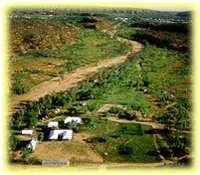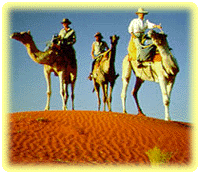 |
 |
 |
|
|||
|
Where in the world do you go to study one of the world's oldest cultures, live in a desert hotel, ride a camel and hitch a lift on a steam engine? It a tough one, and the answer might surprise you -- not in Africa, but the Australian outback. Martin Stott found lots of surprises when he went there for The Savvy Traveler. Explore the Northern Territory
Anyone who goes to Australia visits at least one of the great coastal cities like Sydney or Melbourne. But this is a country with a split personality. And no tourist should leave without seeing the other face of Australia -- the Outback. And in the desert there's no town quite like Alice.
Alice Springs owes much of its existence to the railway that links it with Adelaide -- a thousand miles south. It was built in 1929 and they still have some old steam engines running at the local transport museum -- if you're cheeky enough, you might manage to hitch a lift. But I've come for a more sedate form of transport.
Camel Conductor: "Okay, I'd like you to lean back and hold on for the ride of a lifetime!" Well, it was supposed to be a more sedate form of transport. Sometimes camels have other ideas. There are more single-humped camels in Australia than anywhere else in the world. They were brought from India to help build the railway, and afterwards released into the wild. The Aussie bush obviously suits them. This is the Frontier Camel Farm just outside of Alice Springs. I'm going to ride Nelson. He came from the wild. Michelle Smail's reassuring me he's not about to run back there -- with me hanging on his hump!
Michelle Smail: "What we do is put this little peg in his nostril..."
Big and smoochy isn't how I would describe Nelson. But after a five-mile ride through barren bush I actually become quite fond of him. So I feel a bit guilty revealing my next destination. At the Overlander Steak House in Alice, they love a good camel steak. The chef here is Sean Coulson.
Sean Coulson: "It's a great steak to cook..." I found it a bit chewy. And you know wheat? I'm glad! It doesn't seem right. There's something else that's not right in Alice either. It's the Aborigines. You see them on the streets, dirty and often rolling drunk. It's easy to misjudge these people. Modern civilization hasn't been kind to them. On the outskirts of town under a corrugated metal shack, with chickens running amok around us, I'm privileged to meet Myra Haye Ampatchaina. There's no power, running water or toilet here. This is government land and Myra's considered a squatter. But the old Aborigine won't move. She says this land was stolen from her people. She has to live here.
Myra Haye Ampatchaina: "It's our traditional homeland and we are allowed to stay here all the time. It is very important because our old people used to live around this area. We have to follow our grandparents' footsteps." Aborigines believe the earth was created in the dream time by their ancestors who took the form of all sorts of creatures. The landscape was crafted by their movements -- their drinking, fighting and even their lovemaking. This man is the caretaker of the local stories.
Caretaker: "Many of the local dream time stories are illustrated in Aboriginal dot paintings you can buy here. There's one story I'd love to hear. It's how Uluru was built. But the black fellas won't tell us white fellas everything; we haven't been through the proper initiations. We just come to stare at it. Some try and climb it, but the Aborigines don't like that; this is sacred ground."
Walking round it's enough. Uluru is the Aboriginal name for Ayers Rock. There's a wonderful hotel resort close by. It has a campsite and accommodation of every grade. More importantly, it's eco-friendly. From here you can book tours of Ayers Rock, visit other amazing rock formations nearby, have a meal under the stars and watch an Aboriginal dance show including some amazing performances on the traditional Aboriginal instrument, the didgeridoo. Most people spend a couple of days in Alice and a day at Ayers Rock. I had 10 days there and I learned more about Aboriginal culture in those 10 days than in a year elsewhere in Oz. You will see the drunks, but look closely and you'll also see Aborigines proud of their culture -- made confident by their dance, paintings and music. From the red dusty heart of Australia, this is Martin Stott for The Savvy Traveler. |
 | American Public Media Home | Search | How to Listen ©2004 American Public Media | Terms of Use | Privacy Policy |



